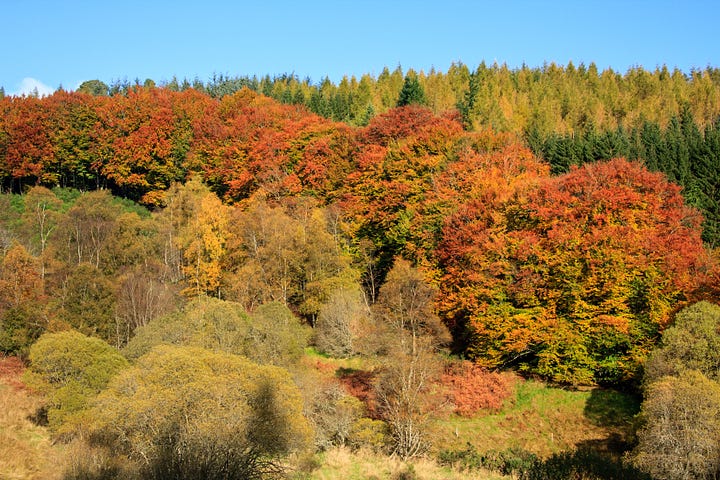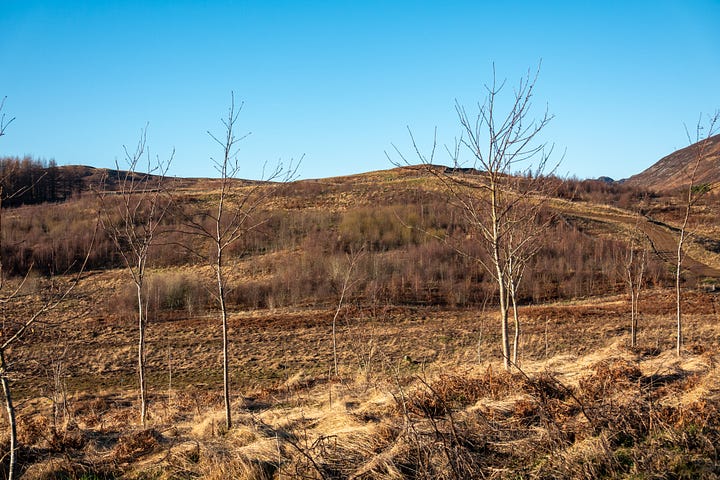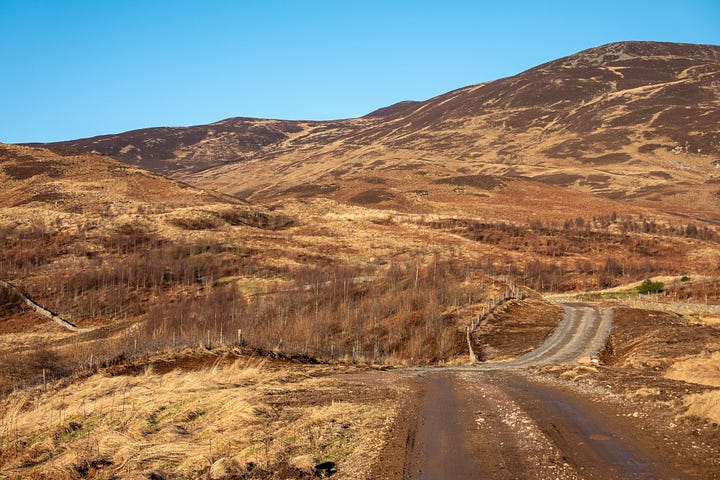What do new estate owners mean for Scotland's land?
Land Use Part 3 - one example of how change is unfolding
Hello if you have recently subscribed to my Substack. To learn more about it how I intend to develop it, see my post Welcome to Our Natural Place. And read the About page for more background.
Today I am returning to my ongoing series about land use in Scotland. It began when I created a video post of a walk Getting high with ancient stones: A stimulating outing on a mild mid-January day. I followed that with a text post about the area I’d explored Discovering hidden history in a magical Scottish landscape: From a Palladian mansion and deserted township to a prehistoric stone circle.
After those I really wanted to delve into the issues that I’d raised about land use and how choices made have wide and lasting impact. Originally this was going to be two or three posts, but the more I have become engrossed in the subject, the more I want to say. So I plan to tackle aspects of this topic bit by bit, often interspersed by other less weighty posts (or at least ones I find less mentally and emotionally challenging!).
You can read the first two parts here:
How did Scotland’s land become so denuded? Part 1 – looking back
Who owns Scotland's land matters: Part 2 - what the situation is now
The new green lairds
In those previous posts I looked the historical pattern of land use, followed by the 20th century picture, using Strathearn in Perthshire as an example. Now, in the 21st century, Scotland is in another period of rapid change. The main driver of this is the concept of natural capital – putting a value on nature so that it can be traded on markets.
I will spear more into this troubling concept in future, but now I am going to look at an example of this new type of land owner in Scotland – often dubbed the ‘green lairds’ – who are buying up estates in the hope of profiting from their natural capital.
In Strathearn the two estates that most recently changed hands have both been bought by companies offering investors a return on natural capital, although as yet it is far from clear as to where those profits will come from. Today I will look at one of them and address the other, Invergeldie, in a subsequent post.
Fordie Estate
This estate lies adjacent to and above Lawers House, which featured in Parts 1 and 2. It rises from the A85 (the trunk road running east west from Perth to Oban) to the summit of Ben Chonzie, a Munro at 3,054 ft (931m). The lower slopes are steep and wooded with rocky knolls, but the gradient flattens on an upland plateau around the shooting lodge of Braefordie, before climbing heathery hillsides to a trig point on Carn Chois (a subsidiary peak) and Ben Chonzie, two miles further north along the ridge.


Fordie Estate was French owned for a decade or two until 2021. Under the influence of its local forest manager, the Louis Vuitton family had developed a mosaic of woodland and upland landscapes that were good for wildlife (as well as sport shooting). Many of the existing forest plantations were managed on a continuous cover basis, with trees left standing while selected ones were harvested. Above these mature conifer forests, in the natural bowl around Braefordie, large patches of native woodland were planted, interspersed with open ground providing grazing and varied wildlife habitats.


Change of ownership
After Xavier-Louis Vuitton put 5,300-acre (2,150-hectare) Fordie Estate on the market, it was bought by Foresight Sustainable Forestry Company Limited, an investment company that “invests in UK forestry and afforestation assets”.
In October 2021 The Telegraph reported,
Foresight sees a big opportunity not only in the booming timber market but also in the surging demand for carbon sequestration among polluting companies looking to offset their emissions.
“We have managed to buy the land at the right price and it’s a very beautiful place,” says Robert Guest, investment director at Foresight. “It’s nice scenery and it’s been well looked after, but it has not been optimised.”
The change of ownership was of interest to the local community. That word ‘optimised’ sounded rather worrying. Many people walk and mountain bike on Fordie Estate so there was concern about how planned changes in land management would affect amenity and access. A core path between Comrie Croft and the village of Comrie runs through Fordie’s woods and many other estate tracks and paths are used for recreation, including those to Balmuick stone circle and up Carn Chois and Ben Chonzie. The estate also includes several houses, some of which are let as holiday cottages.
Forest felling and replanting
Under the Vuitton ownership a 10-hectare (25-acre) larch plantation called Craigmore West, in the southwest of Fordie Estate, was clear felled in the winter of 2012-13. A much neater job was done by the harvesting contractors than in the publicly owned Laggan Wood that lies on the other side of Milton Burn. Both were felled at a similar time, but I suspect Forestry and Land Scotland took the cheapest bid and did little to supervise the work.
The two areas were then managed differently, with Fordie’s land soon planted up with native woodland, including, birch, hazel, oak, rowan, Scots pine, alder and willow. These trees have grown vigorously, soon creating a new wood.
There is a requirement to replant after felling, but Forestry and Land Scotland said they would leave Laggan a few years before doing so (and being part of government I don’t imagine they were being chased by Scottish Forestry, the regulatory arm). They never did replant the felled area, but natural regeneration has now occurred, so the two areas either side of the stream don’t look too different from a distance. Perhaps the public body’s slackness is a good lesson for those involved in rewilding (which I’ll explore more another time) – if grazing pressure isn’t high and there are seed sources nearby you don’t need to plant to create new woodland.
Since Foresight’s purchase of Fordie, they have cashed in on the high timber prices of recent years by felling much larger areas on the estate – over 40 hectares (100 acres) of conifer forest. (Felling trees requires a licence and applications for felling or for woodland creation grants can be found on the Scottish Forestry Public Register). To access the trees, they have forged some new tracks across the land and engineered others from grassy ways to broad, hard-surfaced highways fit for transporting heavy loads.
Mainly non-native species were felled: Sitka and Norway spruce, larch and lodgepole pine. The harvesting has left swathes of ‘bomb site’ hillside, as is normal in UK forestry practice. In due course these areas will be replanted, but meantime wild creatures, including red squirrels, have lost habitat. The submitted replanting plans include some native deciduous trees and Scots pine, but will be largely Sitka spruce, a fast growing species with a good economic return.
New woodland creation
In 2023 Fordie Estate began consulting the local community about plans for a new woodland creation scheme covering a vast area – about 500 hectares (1235 acres). Beinn Liath Woodland Creation was to cover open land above the existing forest and young native woodland, reaching higher up the mountainsides. (Beinn Liath is a small summit on the southern ridge of Ben Chonzie).
There were immediate concerns about how this scheme would affect access, particularly up the hills and to the stone circle. The estate held an open day and also offered tours of the land in a four-wheel drive so people could see the landscapes where planting was proposed. They published maps of where the surrounding deer fence and gates were planned, with patches of various colours denoting where different species of tree would be planted.
I and many others were relieved to see that the proposed planting was for over 50% native broadleaves plus a good amount of Scots pine (our only native conifer). Sitka spruce was included as a commercial crop, but in some of the less prominent areas. Neither straight edges nor rectangular blocks were drawn, with planting outlines curved and relatively natural looking.
Considerable areas of open ground were included in the plan, more than forestry grants would allow for so these areas were marked as ‘non-grant aided’. The same applied to areas of low density native broadleaves, which were planned to soften the upper fringes of the woodland (and allow for natural regeneration in future). Disappointingly forestry grant schemes require a minimum planting density, thus discouraging most landowners from taking a similar, more nature-sympathetic approach.
The estate appeared to listen to feedback, for instance altering planting around the stone circle hill when they realised how much this viewpoint was valued by the local community. On balance most of us felt that the plans would benefit the environment and biodiversity without adversely affecting common routes of access.

Green investments
In December 2022 Foresight Sustainable Forestry Company Plc proudly announced that it had become the first company to officially receive the London Stock Exchange's Voluntary Carbon Market ("VCM") designation. Their press release stated,
“The VCM aims to leverage the power of capital markets to channel capital from corporates and institutions with net zero pledges, into listed companies that are creating high integrity voluntary carbon credits.”
However, their aim to “to facilitate financing at scale into projects that mitigate climate change” seems to have fallen short. On 29 May 2024 The Standard reported that
Foresight Sustainable Forestry became the latest firm to join the exodus from the London Stock Exchange today, as it backed a £167 million offer from private equity.
Averon Park is buying the company and will delist it immediately after the deal goes through.
I find financial wheeling and dealing, and the stock exchange in general, difficult to understand, but I gather from The Standard article that the vision of leveraging capital markets didn’t work out:
There were high hopes that the move toward unsustainable1 and green investing would open up the likes of forestry management as a new asset class, but moves toward a new market have faltered.
I just hope that now Foresight Sustainable Forestry is part of a massive private investment company the plans for Fordie Estate will seen through without adverse alterations (I have yet to spot any planted trees in the mounds dug for that purpose a year ago). Maybe I’m being pessimistic, but I do fear that there is a risk that locals could face the uncertainty of the estate being put on the market again.
I think they meant to write sustainable rather than unsustainable.






'Natural capital'?! Honestly, what a world. I hope that stability and sense prevails in the end. Thank you for sharing this, Felicity.
Really interesting article, I know this area well and walk there frequently. Thank you for this, look forward to reading your other articles